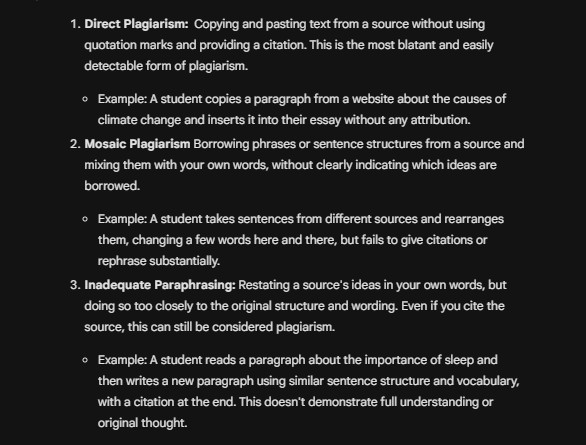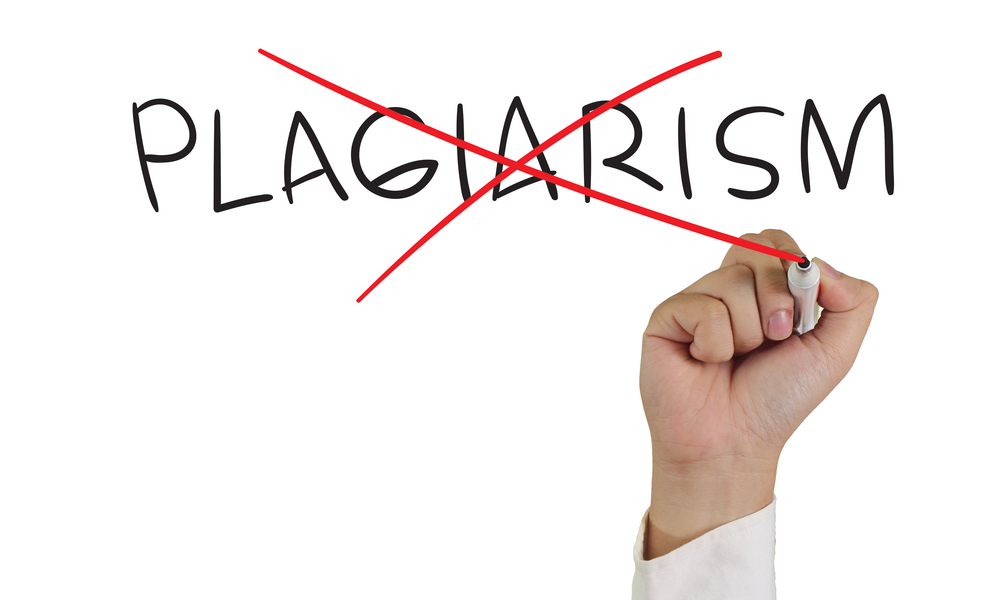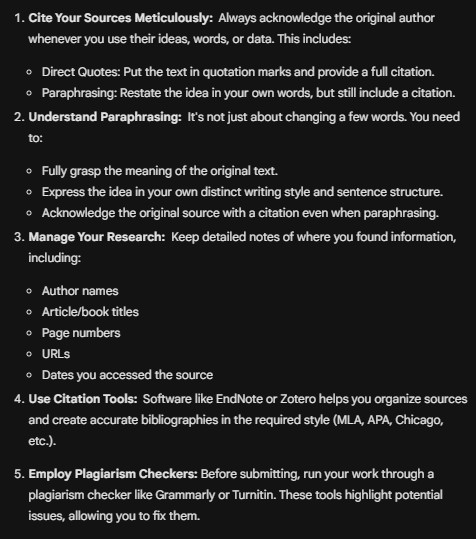Introduction
The best offense is a good defense—and that idea applies to writing as much as it does to sports. In writing, you need to be able to defend yourself against accusations of plagiarism. That means being smart about how you write, how you cite, and how you maintain integrity in research. In this article, we’ll give you some basics to help you improve your game so that you can become an academic all-star without fear of falling.
What is Plagiarism?
Plagiarism is the act of using someone else’s work or ideas without proper acknowledgment. A plagiarist represents somebody else’s work as his own original effort. Plagiarism is a big no-no in academics, but it can get you into big trouble in any context that involves copying text, copywrite infringement, borrowing concepts, or failing to cite sources appropriately even when paraphrasing text.
You might get far by plagiarizing your way to the top—but you’ll eventually get found out in the end (see Harvard’s former president Claudine Gay, for example).
- Plagiarism is considered a breach of ethics and a serious academic offense.
- Penalties are not to be taken lightly but can range from loss of credibility (if the offense is mild) to more severe institutional consequences (like loss of admission).
- Not all plagiarism detection tools are created equal. Find one that really works—and we’ll show you how below!
View 120,000+ High Quality Essay Examples
Learn-by-example to improve your academic writing
Prevalence in Academic Settings
In academics, plagiarism is an issue that everyone hears about all the time. Students, teachers, researchers, administrators—they all have to be mindful of what it is and how it can hurt reputations and chances in life. Yet, in spite of all the warnings, it still happens.
So why is that? Simple. The accessibility of digital resources and the pressure to perform well can sometimes lead people to plagiarize, even without fully understanding how they are doing it or the implications of their actions. Even something as flubbing citation styles could potentially get one in trouble for plagiarism—so this needs to be taken very seriously.
Educators and institutions are constantly on the lookout for plagiarism in assignments, research papers, theses, and dissertations. Almost all of them have some kind of stringent checks in place and maintain educational campaigns about the importance academic integrity.
Importance of Addressing Plagiarism
Addressing plagiarism is important for the sake of maintaining academic integrity and supporting real intellectual growth. The first place to start is with knowledge of the ethical and procedural aspects of scholarly work. This is what forms the foundation of research and professional conduct. And this is how educational institutions cultivate a culture of honesty and respect for intellectual property, both of which are crucial for academic and professional success.
Types of Plagiarism
Direct Plagiarism
Direct plagiarism is when a person copies text word-for-word from a source without using quotation marks or properly citing the source. This type of plagiarism constitutes a deliberate act of intellectual theft and is the most easily detected when a work is run through plagiarism detection tools.
Self-Plagiarism
Self-plagiarism involves reusing one’s own previously published work without properly citing the previously used work. This could include submitting the same paper for different classes or integrating part of your earlier work into new research without acknowledgment. Although there are questions about redundancy and originality of scholarly contributions, self-plagiarism is generally frowned upon.
Mosaic Plagiarism (Patchwriting)
Mosaic plagiarism, or patchwriting, involves piecing together ideas or phrases from various sources and blending them with your own writing without proper citations. This type of plagiarism can sometimes be unintentional—especially when one is in a rush. But you need to be aware of it and take precautions.
Accidental Plagiarism
Accidental plagiarism occurs when a person neglects to cite their sources correctly or fails to paraphrase adequately without having the intent to deceive. Although accidental, this form of plagiarism can still result in academic penalties—like failure on a paper or for an entire course. Avoiding it means taking the time to do things the right way. Still, it can happen even to the best of us.
- For example, the South Park creators did it when they spoofed the movie Inception in episode 205 by ripping off a College Humor YouTube sketch. They were in such a rush they did not realize they were literally lifting lines nearly verbatim from the sketch they had just watched.
Examples of Plagiarism
Direct Plagiarism Examples
- A student copies several paragraphs from a digital book without making any changes or giving citations, and presents the material in a term paper as if it were his own.
- An author “borrows” portions of text from different public websites and includes them in his report without giving any clear attribution and thus allowing the reader to have the impression that the “borrowed” portions are indeed the author’s own words.
Self-Plagiarism Examples
- A university professor uses large segments of his previously published papers to write a new article, without citing the earlier works. Now there are multiple publications with identical content.
- A graduate student recycles part of his master’s thesis for a doctoral dissertation proposal and does not disclose that the material has come from a prior work.
Mosaic Plagiarism (Patchwriting) Examples
- A journalist takes excerpts from several news articles, slightly modifies the language, and integrates them into a new article, making it difficult to trace the original sources without proper citations.
- An academic takes parts of text from multiple student theses, makes minimal rewording, and incorporates them into a new research paper, creating an appearance of originality while primarily using others’ works.
Accidental Plagiarism Examples
- A blogger refers to several statistics and facts gathered from an industry report but fails to mention or link to the original source, and thus inadvertently presents them as his own research and independently verified figures.
- A student uses technical terms and definitions from a textbook in his essay without realizing these need to be cited, mistakenly assuming that they are common knowledge.

Plagiarism and Artificial Intelligence (AI)
Rise of AI in Academia
The integration of artificial intelligence (AI) into all aspects of life has not escaped the notice of academics. AI tools are everywhere and they can now be used in research, writing, and even the grading of assignments. These tools can analyze large datasets, suggest relevant literature, make improvements to text, and help in structuring and proofreading academic papers. Sounds great, right? But it’s not all roses. There are some real problems with AI in this respect.
For starters, AI undoubtedly acts as a powerful resource for learning and research, but it also can facilitate plagiarism. That’s because AI is really just scanning what’s already out there for consumption, lifting from it, rewording it a bit at times (but not always), and sending it on to the user. Students who rely on AI, using its outputs as their own, are not actually doing themselves any favors.
- First, they are hindering their own learning process and encouraging dependency.
- Second, they are inevitably taking the words of someone else and using them as their own.
- And since AI isn’t great about citing its own sources, a user of AI is already on the road to plagiarism and just waiting to get called out.
Detection Challenges
Plagiarism detection software traditionally scans for direct matches and paraphrased content from documented sources. However, the advent of AI-generated content poses new challenges. Advanced AI models can rephrase ideas and generate seemingly new content that may not directly match existing sources although it still lacks original thought from the user. This initially created a blind spot for conventional plagiarism detection tools. However, new advancements such as those featured in our free plagiarism checker have begun to address these issues. These tools are now capable of detecting nuances in text that may suggest AI involvement. Distinguishing between AI-assisted work and student originality will likely always be a challenge that is found the eye of the beholder—but this checker helps raise some flags.
Evolving Definitions of Plagiarism
AI certainly complicates the traditional definitions of plagiarism. The ultimate question for now is this: does using AI-generated content without disclosure constitute plagiarism? \
This debate is ongoing in academic circles. Some argue that the undisclosed use of AI tools violates the principles of originality and integrity in the same way as plagiarism. Others see it as a form of assistance, no different in principle than citing information from a published source. In response, academic institutions are beginning to revise policies to clarify the boundaries and expectations regarding AI-generated content. This includes stipulating that all AI-assisted work should be clearly acknowledged, setting a precedent for transparency and accountability in student submissions.
Preventive Measures and Ethical Considerations
In response to these challenges, it is not surprising to see an increased focus on developing tools and strategies to detect AI-assisted plagiarism. These tools look for textual matches and analyze writing styles and inconsistencies that line up with patterns found in all AI-generated content.
Ethical considerations have to be made. Educators and students are walking near a fine line between seeing AI as a tool for learning and relying on AI in ways that compromise educational integrity. Academic policies are changing as a result, and students need to be on guard. They need real critical thinking and problem-solving skills independent of AI assistance—or they might find themselves being hauled into the dean’s office with a lot of explaining to do.
View 120,000+ High Quality Essay Examples
Learn-by-example to improve your academic writing
The Consequences of Plagiarism
Academic Consequences
Plagiarism can have serious academic and professional consequences. All educational institutions have strict rules against plagiarism, and students found guilty will face penalties that can range from failing grades on assignments to more severe punishments like suspension or expulsion.
These measures are intended to uphold academic integrity. Students need to realize the importance of originality and hard work in all their scholarly endeavors. AI may make it seem like it is now possible to skate by—but pay attention to that word “seem”. Sooner or later, plagiarism gets found out.
The stigma of being caught plagiarizing is no fun. It can cost you your reputation and ruin whatever chances and opportunities for scholarships or jobs you might have had.
Professional Consequences
That’s right, the repercussions of plagiarism can even affect your professional life. Professionals who are discovered to have plagiarized work may lose the trust others placed in them. They may face legal implications such as lawsuits for copyright infringement or breach of contract, especially in fields where intellectual property is important. The discovery of plagiarism can result in job termination. It is nothing to take lightly.
Legal and Ethical Consequences
Legally, plagiarism can constitute copyright infringement, which is punishable by fines and sanctions. Ethical consequences are equally significant, as plagiarism undermines the fundamental values of intellectual honesty and integrity. It breaches the ethical contract between the writer and the reader, and between the student and the educational institution. Once trust is lost, it is almost impossible to get it back.
Discussion of Real-Life Cases
Several high-profile cases of plagiarism show the seriousness of its impact. Claudine Gay, president of Harvard, is one of the latest examples of someone plagiarizing her way to the top only to get found out in the end. Neri Oxman, wife of investment hedge fund manager Bill Ackman, is another academic who was called out for plagiarism. In fact, both Oxman and Gay copied text from other researchers without citing the original authors, as Business Insider pointed out.
Free Plagiarism Checker
Overview of Our Plagiarism Checker Tool
Our plagiarism detection tool offers an effective solution for identifying potential plagiarism. This tool scans documents against a vast database of sources, including books, articles, journals, and websites, to detect similarities and potential instances of plagiarism. It provides detailed reports that highlight direct matches and passages that look like paraphrasing. The goal is to help writers maintain originality in their work by removing, citing properly, or rewriting entirely, any flagged passages.
The Role of Technology in Identifying and Preventing Plagiarism
Technology has certainly developed in terms of combating plagiarism. Advanced algorithms and extensive databases exist now that can detect plagiarism in an instant. Software to scan and compare texts quickly and accurately is readily available to both educators and publishers alike so that they can maintain the integrity of academic and professional publications. However, these tools are not just for them. Students should be using them, too, so that they can learn where they might be running a risk in their own research and writing.
Limitations of Plagiarism Detection Software
Of course, no set of plagiarism detection tools are infallible. For one thing, they may not detect all forms of plagiarism, such as ideas plagiarized from spoken presentations or images. For another, these tools might flag common knowledge or incorrectly identify properly cited quotes as plagiarism. Understanding these limitations is important because users must still exercise human judgment in determining the context and intent behind potential instances of plagiarism.

How to Avoid Plagiarism
Importance of Proper Citation and Referencing Styles
Understanding and using proper citation styles—such as APA (7th edition), MLA (9th edition), and Chicago (9th edition)—is a big help in avoiding plagiarism. These styles provide a systematic method for formatting academic documents and citing sources. Each style has specific rules for documenting sources. When you know how to cite according to one of these methods, it makes the whole process easier, and helps keep you free from slipping inadvertently into plagiarism.
We offer citation guides on the most popular citation methods, including MLA, APA, and Chicago Turabian. You can also use our citation generator to help you create your bibliography or works cited page.
Tips for Effective Paraphrasing and Summarizing
One way to effectively paraphrase is to use your own words and voice to convey meaning that you’ve uncovered elsewhere. You’ll still want to provide a citation to show where the meaning comes from—but paraphrasing shows the reader that you own the understanding.
- Don’t be afraid to let your voice and words out.
Summarizing involves condensing the main ideas of a text into a brief overview. You can do this by identifying the main arguments of a text often found at the beginning (in the Abstract if there is one, or in the intro).
- Both skills are essential in academic writing and help to show comprehension and respect for source material.
Encouragement of Original Thought and Critical Thinking
Original thought and critical thinking are mandatory!
Encourage these skills within yourself so that you can start to engage deeply with content and not just be tempted to lift it and pass it off as your own. As a writer, it is your job to engage and contribute something new—not borrow and rehash what is old!
Resources for Further Learning and Practice
Most colleges offer tutorials or have writing centers that provide guidance on how to cite sources and watch out for plagiarism.

Educating on Plagiarism
Strategies for Educators to Teach Students about Plagiarism
Strategies for teachers can include lessons on intellectual property rights, using plagiarism detection software as a teaching tool, and assigning projects that help students develop critical thinking skills. Teachers can also pull up examples of plagiarism to help students distinguish between both intentional and unintentional violations.
The Role of Institutional Policies in Plagiarism Prevention
Institutional policies need to set clear expectations about academic honesty. They need to define plagiarism, and explain the consequences and procedures for handling allegations. The clearer the policy, the more likely students are to take it seriously.
Creating a Culture of Integrity and Honesty in an Academic Environment
Creating a culture of integrity means promoting character education. Character education should be a fundamental aspect of education at every level. When the character is well-formed, the culture will be as well.
Conclusion
To maintain academic integrity, every needs to step up their game to prevent plagiarism. Information is available at the tips of one’s fingers thanks to the rise of digital media. It’s easier now than ever before to steal—but it’s also a lot easier for others to find you out.
Also, remember to try our free plagiarism checker tool. Use it to make sure your writing is actually as original as it can and should be. You can also start up a conversation about ethics in writing and research at your own college. Get involved in discussions and forums where these topics can be examined. Finally, you can have your essay edited by our team of highly qualified writers. Our writers will make sure your paper is 100% properly cited, as well as check for any other errors such as grammar, spelling, and flow.





